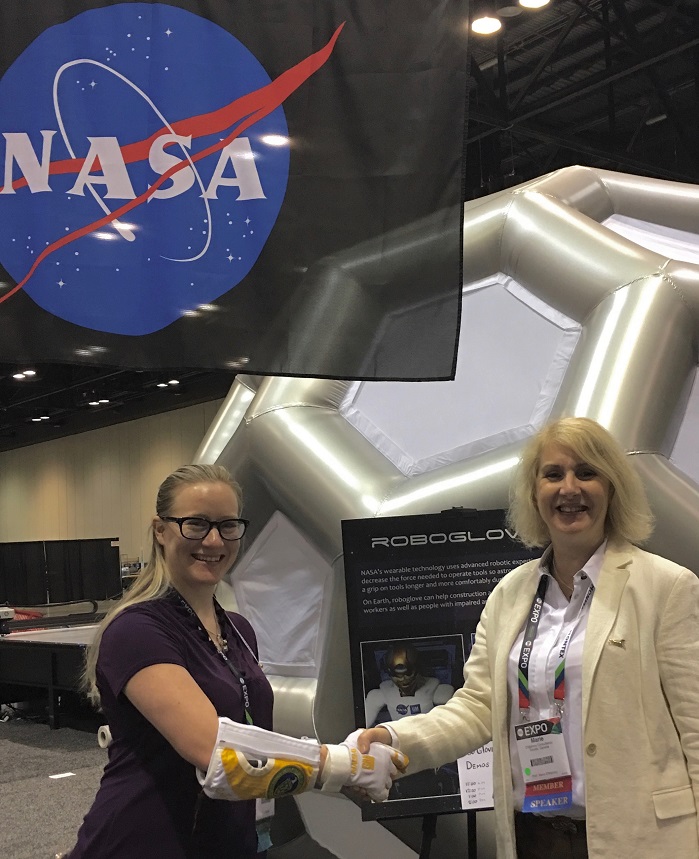
Automated Sewbot to make 800,000 adidas T-shirts daily
Opinion


Next year marks the centenary of the word 'robot' in Karel Capek’s play R.U.R., where the intelligent machine in the workplace is portrayed as a threat to mankind.

13th November 2019
Marie O'Mahony
|
US

Shaking hands with NASA’s Emily McBryan and Robo-Glove. © Marie O’Mahony
Next year marks the centenary of the word robot in Karel Capek’s play R.U.R., where the intelligent machine in the workplace is portrayed as a threat to mankind. Their physical hardness and rigidity has become a visual shorthand for their non-human or otherness. As applications for robotics have moved to include the human body as well as the workplace and the environment, there has been a noticeable emphasis on robots that are softer and more flexible with textiles assuming a greater role in how they are now imagined.
In his first editorial for Soft Robotics launched in 2013, Editor-in-Chief Barry Trimmer explained the motivation behind the journal: “by building soft materials into the fundamental design of machines, or by building them completely from soft materials, we add a new dimension to design and create an untapped resource for entirely new types of machinery”.
This marks an important shift in the technological mindset around what a robot can be and how it can function alongside, even augmenting humans. In space, military, medical and material applications robots are finding new ways to bring benefit made possible by their unique attributes that can include strength, intelligence, flexibility and softness.
Before mankind set foot on the moon, NASA had sent Ranger, Surveyor and Lunar Orbiter robots to gather and transmit information in preparation for human travel to Space. Designed for performance and ruggedness, these look and behave in ways that are most commonly associated with robots for Space research.
However, designers of soft-goods at NASA are combining robot technology with apparel in the design of their Robo-Glove. Sensors placed in the fingertips of the glove allow for the fingers to be set rigid to grip tools or equipment, then pressed again to release. This provides muscle support without compromising dexterity through the thick protective layers of the glove. Molly Harwood, one of the NASA designers describes it as “feeling like power steering for your hands”.
Sensors and actuators can be incorporated as wearable technology, which, of course, this robo-glove is. But in bringing it to the level of robotics the expectation and approach are shifted towards a higher level of physical support beyond what a textile-first design might deliver.
Much of the emphasis in US military close to or on-body robotics has been focused on exoskeletons with developments such as the Human Universal Load Carrier (HULC) relieving muscle strain on the wearer traversing rough terrain in strenuous and stressful conditions. However, treatment of injured soldiers is also an area of research.

NASA’s Robo-Glove gripping action. © Marie O’Mahony
A multidisciplinary team from the University of Pittsburgh School of Medicine is developing TRAuma Care in a Rucksack (TRACIR). Robotics are brought together with Artificial Intelligence (AI) to develop a hard and soft robotic suit with embedded sensors capable of assessing the injuries of the patient as they are placed within it. AI algorithms help to direct critical care and apply stabilising treatments such as intravenous fluids and some medication.
Ron Poopatich MD, Director of Pitt’s Centre for Military Medicine Research and Principal Investigator (PI) on the US$ 3.1 million contract sees it as being particularly beneficial in remote combat zones where soldiers cannot be evacuated easily: “By fusing data captured from multiple sensors and applying machine learning, we are developing more predictive cardio-pulmonary resuscitation opportunities, which hopefully will conserve an injured soldier’s strength.”
The approach to soft robot research at the Wyss Institute for Biologically Inspired Engineering exemplifies the breadth of approaches to the field. In one project a collaboration with Harvard SEAS has led to the development of a multi-joint soft exosuit. The use of a machine-learning algorithm allows them to efficiently personalise the control strategies for individual soft wearable exosuits.
In another development origami has inspired a design for soft yet strong artificial muscles capable of lifting up to on thousand times its own weight. A Pop-Up Mems manufacturing technology is allowing the creation of a flexible hybrid sensor small enough to be used with a surgical endoscope. Four layers of laser-machined stainless steel and sandwiched with a flexible polymer layer and laminated to allow for self-assembly with copper providing the electrical contacts.
The manufacturing process sees the material agitated in an ultrasonic bath so that the 2D material “pops up” into a 3D sensor via an integrated spring with a footprint of just 2.7mm. This mixing of hard and soft layers in not unlike the hard abalone shell, something that Biomimicry-inspired textile technologists have long looked to emulate.
A couple of decades ago artificial skin was focused on replicating human skin in appearance. Usually made of a polyurethane, it often acted as an inert aesthetic covering for robotics or prosthetics. Now, just as e-textiles look for greater integration between electronics and textiles, roboticists are seeking ways for robot and skin to become as one.
Researchers at the Institute of Ion Beam Physics and Materials Research in Dresden are working on an electronic skin that is bifunctional, capable of simultaneous tactile and touchless stimulation using a magnetic microelectromechanical (m-MEMS) system. The ability to distinguish between different types of stimuli has the potential to offer new capabilities in areas such as Augmented Reality (AR) and Medicine. In a paper published in Nature Machine Intelligence, researchers at the University of Southern California point to the potential for new developments in soft robotics and multi-sensory abstraction to lead to a new field of machine intelligence where they would exhibit equivalence to feelings and offer a way to investigate consciousness, intelligence and the process of feeling.
As textiles and apparel look to encourage non-textiles industries to consider the advanced and smart capabilities of textiles, these developments emerging from robotics are a timely reminder that an openness to new ideas and product development works both ways and the textiles industry too has much to learn from other fields.

Business intelligence for the fibre, textiles and apparel industries: technologies, innovations, markets, investments, trade policy, sourcing, strategy...
Find out more